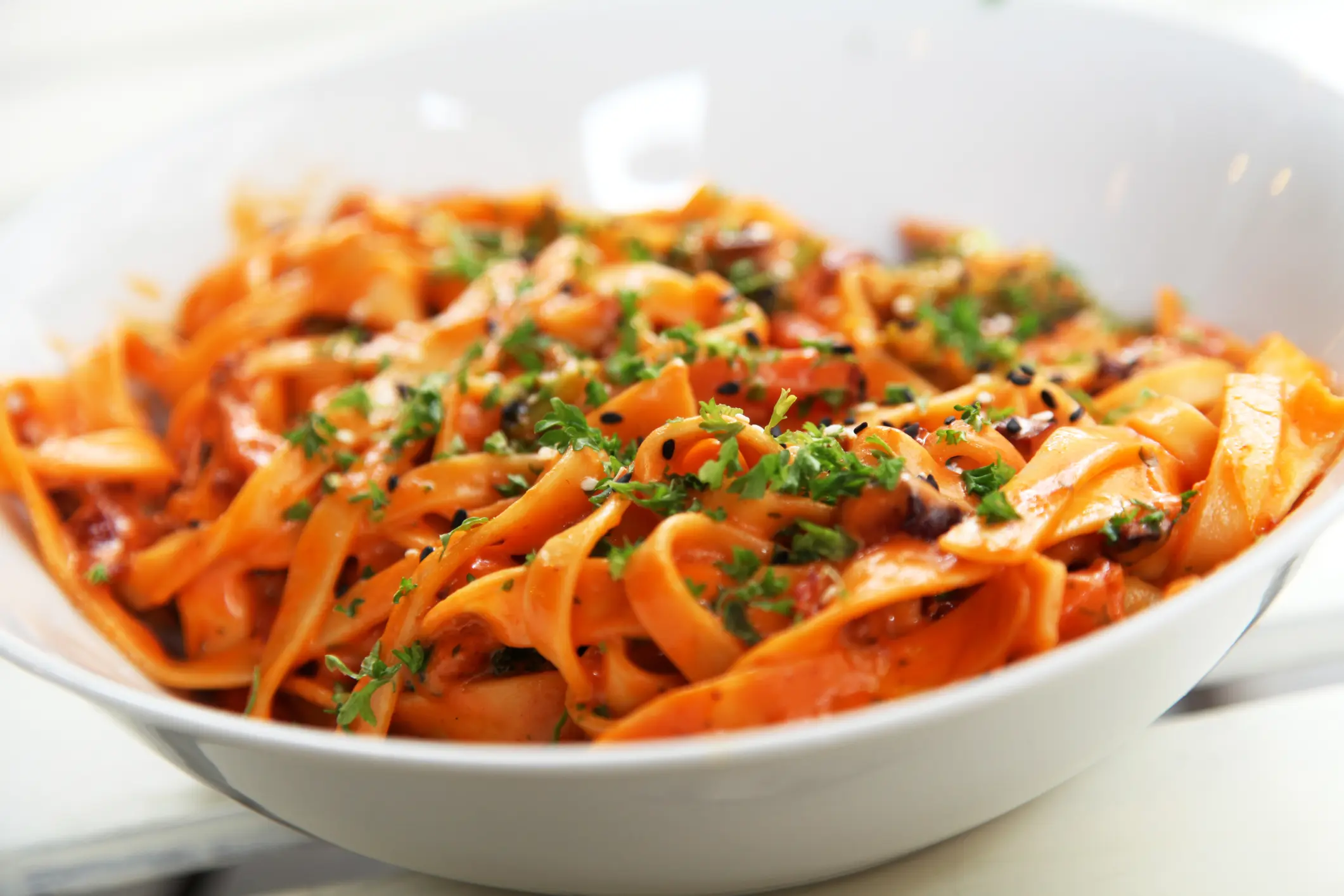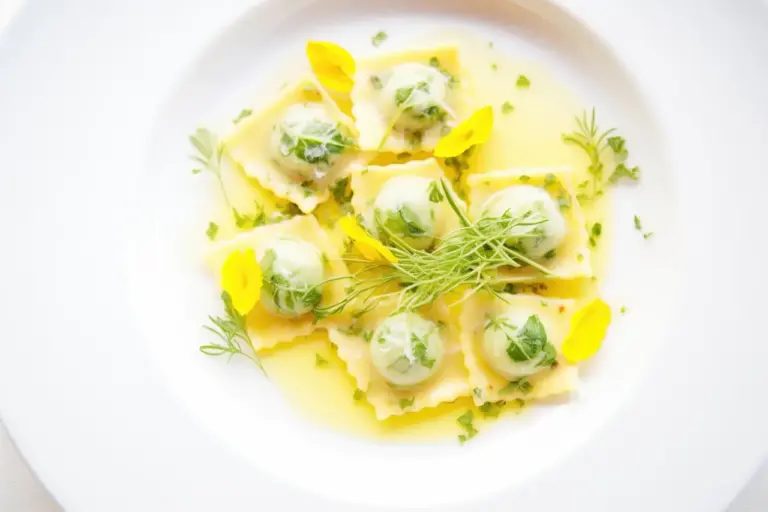How To Make Red Lentil Pasta
This simple homemade Red Lentil Pasta is made with only 3 ingredients, and it’s easy to make. It’s high in protein, high in fiber, and gluten-free. This recipe can also be made vegan by removing the eggs.
I feel like I’ve said this in every single past post that I’ve written, but – you wouldn’t believe how simple it is to make homemade pasta! Having already posted All-Natural Homemade Rainbow Pasta and Vegan Pasta (among other pasta recipes), I thought I’d try my hand at this gluten-free pasta alternative: red lentil pasta.
Table of Contents
ToggleThis red lentil pasta comprises just three ingredients: gluten-free lentil flour, eggs (or flax eggs), and olive oil. Homemade red lentil flour is ridiculously easy (and cost-effective) to make at home, making this pasta just as cost-effective and a delicious way to enjoy a lunch or dinner.
Legume pasta is gaining in popularity, and for good reason. Legume pasta is a good option for those who have gluten issues. It also has more nutrients and benefits than traditional pasta.
Red lentils are not only chock full of protein, but they’re also high in fiber, several vitamins, minerals, and antioxidants, and even rich in healthful plant compounds and antioxidants (read more of the benefits in my lentil flour post). The flour, while nutty and lentil-y in flavor, blends well into a flavorful pasta and pairs well with any sauce.
How to deal with gluten-free pasta
It’s true, that gluten-free pasta does not behave in the same manner as regular pasta when it is cooked. However, that doesn’t make it any less enjoyable. You just have to learn to cook the pasta a little differently.
Gluten-free spaghetti can indeed overcook, become mushy, or even crumble. It’s easy to fix this problem by knowing the cooking time of the pasta. This red lentil pasta will not break down when overcooked because it does not contain gluten.

The Step-by-Step Instructions
Step 1: Prepare red lentil pasta dough
- Pour the lentil flour onto a dry, clean surface. In the middle, create a well and add the olive oil and eggs (or flax eggs).
- Mix/knead the dough until it is homogeneous. The dough will be more fragile compared to pastas containing gluten.
- Form the dough into an oblong ball, and leave it for 10 to 15 minutes. It will be easier to cut and handle.
- You can add water if the dough seems a bit crumbly. Add one tablespoon at a time until the dough forms.
Step 2: Shape/Chop your homemade pasta
- Divide the dough into smaller pieces. I cut it into five or six pieces.
- Cut each sheet of dough into the desired shape. You can make pappardelle, or even thinner noodles, bows, etc. A pasta press can be used to make noodles, macaroni, or penne.
Note: The pasta machine can be used to roll the dough out. Start by rolling out the dough with a rolling pin to fit into the widest setting of your pasta machine. Feed it through the pasta machine several times to thin it out until you reach the desired thickness.
- To cut into tagliatelle/pappardelle by hand, take your rolled-out dough (the length that you’d like your pasta noodles to be). Roll it up and liberally flour it. Cut the dough with a sharp knife into as thin or as wide as you like.
Step 3: Cook or store the lentil pasta
- To prevent them from sticking together, sprinkle more flour on top of the pasta shapes (I use lentil flour).
- The pasta can be cooked immediately or stored in the refrigerator or freezer.
- Pour cook the pasta, put it in a pot with boiling salted water. Cook for 5-6 mins, stirring every 20-30 secs to ensure the pasta does not stick together. Serve with the sauce of your choice.
There are some tips I can give you for using gluten-free pasta, such as this lentil pasta.
Tips for a Successful Pasta
- Do not overcook pasta: I know that I have already said it, but I feel the need to reiterate. Overcooking pasta will make it mushy or fall apart because of the lack of gluten. Once the pasta is al dente, it should have a slight bite to it but not be too soft or firm. After draining, it will continue to cook.
- Stir pasta: Gluten-free pasta may clump if it is not stirred often at the start of cooking. Stir the pasta in the pan for the first 20-30 seconds. Stir the pasta gently every 30-40 seconds for the first three to four minutes of cooking.
- Do not skimp on salt. This is a good tip for any pasta-making, but it’s worth mentioning. When salting your cooking water, be liberal. You need to use a lot of salt because your pasta will not absorb it all.
- Drain the pasta and add it quickly to the sauce. Once the pasta has been cooked, it will need to be drained. This is important as pasta will get stuck in the colander if it’s left there for too long. Stir the sauce into the pasta and add it back to the pan.
- Cook with extra water: Since gluten-free pasta tends to be more starchy, you may want to add more water. This will help to reduce the starchiness and prevent the pasta from sticking.
- Save a little pasta water. Following on from the tip above, you should save some pasta water and add it to your sauce. You might be surprised by how absorbent gluten-free pasta can be. It’s super convenient to have extra liquid on hand to increase the sauce.
- Red lentil Flour – I use homemade.
- Eggs – for a vegan version, you can use flaxseed eggs.
- Olive oil
- Optional: Add a tsp of xanthan gum for a slightly more pliable dough – to make up for the lack of gluten.
How to make ahead and store
- The fresh pasta can be stored in an airtight container for up to 1-2 days in the refrigerator or frozen for 2-3 months. It can also dried, either by dehydrating it at room temperature or using a dehydrator. The shelf life of egg-dried pasta is a subject of debate due to salmonella. To be on the safe side, I store my dried pasta in a container that is airtight in a cool place and use it in less than a month. You can freeze-dried pasta between 5-6 months.
- Dry the pasta: Use a dehumidifier or a large tray to dry the pasta in an area with good ventilation.
You can start by drying them flat, for about 1-2 hours. When the pasta is still firm, but pliable, you can form it into nests.
The drying time can vary depending on the humidity and climate. I wouldn’t dry pasta if you live in a very humid area.
Equipment
- Pasta machine optional
- Grain mill optional to grind lentils into flour
Ingredients
- 1 Tbsp olive oil
- 7 oz Red lentil flour More for Dusting
Nutrition
Serving: 1serving. Calories 475kcal. Carbohydrates 60g. Protein 31g. Fat 12g. Saturated fat 2g. Polyunsaturated fat 2g. Monounsaturated fat 7g. Trans Fat 1g. Cholesterol 164mg. Sodium 69mg. Potassium 1008mg. Fiber 30g. Sugar 2g. Vitamin A 276IU. Vitamin C 4mg. Calcium 80mg. Iron 8mg
The nutrition information is calculated automatically, and should only be used to approximate.

Red Lentil Pasta
Method
- Pour the lentil flour onto a dry, clean surface. In the middle, create a well and add the olive oil and eggs (or flax eggs).
- Mix/knead the dough until it is homogeneous. The dough will be more fragile compared to pastas containing gluten.
- Form the dough into an oblong ball, and leave it for 10 to 15 minutes. It will be easier to cut and handle.
- You can add water if the dough seems a bit crumbly. Add one tablespoon at a time until the dough forms
- Divide the dough into smaller pieces. I cut it into five or six pieces.
- Cut each sheet of dough into the desired shape. You can make pappardelle, or even thinner noodles, bows, etc. A pasta press can be used to make noodles, macaroni, or penne. Note: The pasta machine can be used to roll the dough out. Start by rolling out the dough with a rolling pin to fit into the widest setting of your pasta machine. Feed it through the pasta machine several times to thin it out until you reach the desired thickness.
- To cut into tagliatelle/pappardelle by hand, take your rolled-out dough (the length that you’d like your pasta noodles to be). Roll it up and liberally flour it. Cut the dough with a sharp knife into as thin or as wide as you like.
- To prevent them from sticking together, sprinkle more flour on top of the pasta shapes (I use lentil flour).
- The pasta can be cooked immediately or stored in the refrigerator or freezer.
- Pour cook the pasta, put it in a pot with boiling salted water. Cook for 5-6 mins, stirring every 20-30 secs to ensure the pasta does not stick together. Serve with the sauce of your choice.
Notes


